
Beatification is a recognition accorded by the Catholic Church of a deceased person's entrance into Heaven and capacity to intercede on behalf of individuals who pray in their name. Beati is the plural form, referring to those who have undergone the process of beatification; they possess the title of "Blessed" before their names and are often referred to in English as "a Blessed" or, plurally, "Blesseds".
The process of beatification and canonization has undergone various reforms in the history of the Roman Catholic Church. For current practice, as well as a discussion of similar processes in other churches, see the article on canonization. This article describes the process as it was before the promulgation of the Codex Iuris Canonici of 1983.

Karolina Gerhardinger was a German Roman Catholic religious sister who founded the School Sisters of Notre Dame. Gerhardinger served as an educator in Bavaria until the establishment of her order, which provided free education to the poor and soon expanded in Europe.
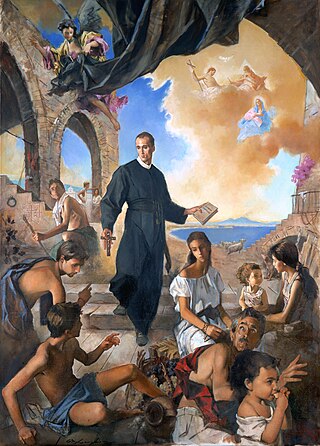
Gennaro Maria Sarnelli was an Italian Roman Catholic priest and a professed member from the Redemptorists. Sarnelli was one of Alphonsus Maria de' Liguori's earliest companions and a prolific writer on a range of religious topics. He wanted to become a Jesuit though was dissuaded from this before working in the Hospital of the Incurables where he call to the priesthood blossomed. His apostolic zeal knew no limits: he preached missions and aided his friend Liguori in his work; he tended to the sick and helped to get girls out of prostitution despite the threats levelled against him.

Giuseppe Toniolo was an Italian Roman Catholic economist, sociologist, and pioneer of Christian democracy. A leading political and social economist, Toniolo condemned both socialism and laissez-faire capitalism, advocating instead for an economic system in which social, judicial, and economic forces cooperate proportionately for the common good. Toniolo was an early Catholic advocate of labour unions and social reform. Describing the economy as an "integral part of the operative design of God," his work was inspired by Catholic social teaching.

Pius of Saint Aloysius was an Italian Roman Catholic professed cleric from the Passionists. He died before he could receive his ordination to the priesthood but in his short life managed to captivate people around him for his strong dedication to his order's charism and his deep faith.
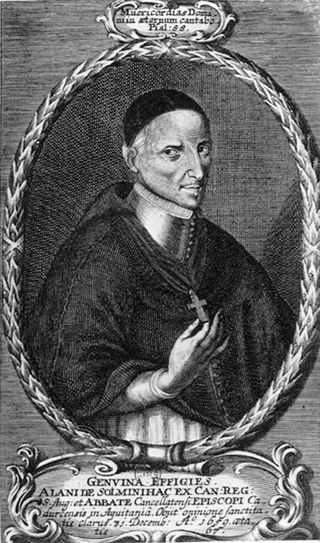
Alain de Solminihac was a French Roman Catholic religious reformer and served as the Bishop of Cahors from 1636 until his death.

Clelia Barbieri was an Italian Roman Catholic and the founder of the Little Sisters of the Mother of Sorrows. She is regarded as the youngest founder of a religious congregation in the history of the Catholic church, as she was just twenty-three when she died. Barbieri declined the married life in her adolescence – even when pressured – in favor of leading a life dedicated to the needs of others; she served as an educator for a while and joined a religious movement which made her a notable figure in her village.
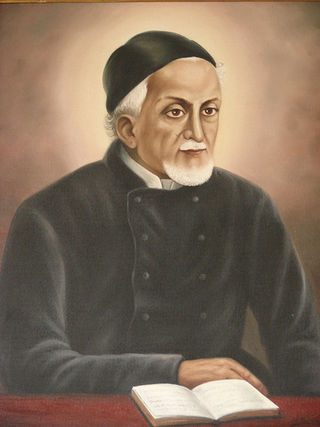
Gaspare Luigi Bertoni, CSS was an Italian Catholic priest and the founder of the Congregation of the Sacred Stigmata, also known as the Stigmatines.

Luigi Guanella was an Italian Roman Catholic priest. He was ordained a priest on May 26, 1866 in Como, and was assigned to a small parish in Savogno. Luigi is the founder of several religious institutes: the Daughters of Saint Mary of Providence (1890) and the Servants of Charity alongside his friends David Albertario and Giuseppe Toniolo. Guanella also founded the Pious Union of Saint Joseph (1914) with his supporter and first member Pope Pius X. These religious communities focused on the relief of the poor throughout the world. The Servants of Charity motto reads "In Omnibus Charitas", which became the cornerstone for Guanella's own life.

Jacques-Désiré Laval was a French Roman Catholic priest who served in the missions in Mauritius; he was a professed member from the Spiritans. He is known as the "Apostle of Mauritius" due to his tireless work in aiding the poor and ill. Laval also educated the flock he was assigned to for those people were uneducated and were former slaves for the most part. His skills in medicine made him a distinguished figure in the region since his expertise allowed him to tend to those who suffered illness that manifested more so during times of an epidemic.

Franz Josef Rudigier was an Austrian Roman Catholic prelate and served as the Bishop of Linz from his appointment in 1853 until his death. Much of his local diocese grew due to his vigorous in promoting evangelic zeal and fundamental religious principles. He became the intellectual figurehead for Catholics in their struggle with liberalism. He promoted the Christian press and took a visible stand defending the 1855 concordat, when liberals annulled it without papal consultation in 1870. A beatification process for Rudigier was initiated under Pope Pius X in 1905 and he was titled as a Servant of God. The confirmation of his life of heroic virtue allowed for Pope Benedict XVI to name him as Venerable in 2009.

Rafaela Ybarra Arambarri de Vilallonga is a Spanish Roman Catholic widow and the founder of the Sisters of the Holy Guardian Angels. Vilallonga was part of Bilbao's upper-class and she mothered seven children with her husband José Vilallonga.
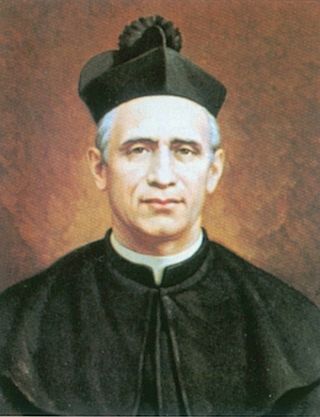
Giovanni Battista Piamarta was an Italian Roman Catholic priest and educator. Piamarta was also the founder of the Congregation of the Holy Family of Nazareth. Piamarta established his congregation in 1900 in order to promote Christian education across the Italian peninsula. Piamarta also founded the Humble Servants of the Lord.

Giuseppe Benedetto Dusmet – born Giuseppe Dusmet – was an Italian Roman Catholic cardinal who served as the Archbishop of Catania from 1867 until his death. He became professed into the Order of Saint Benedict where he took "Benedetto" as his religious name. He studied under the Benedictines prior to joining them before serving as a professor in addition to prior and abbot. His elevation to the episcopate saw him distinguish himself in cholera epidemics when he tended to the ill while also remaining a strong advocate for the poor of his archdiocese. He remained a Benedictine and was known to continue to don the Benedictine habit instead of the red cardinal's regalia.
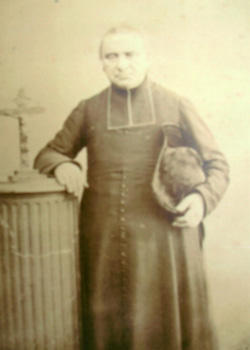
Louis-Édouard Cestac was a French Roman Catholic priest and alongside his sister Marie-Louise-Élise co-founded the Serviteurs de Marie. Cestac was dedicated to the needs of the poor and he met with them on a frequent basis in order to get to know them better and to know how he could better serve them in terms of their material and spiritual needs. But he was concerned for girls who were poor and destitute and so decided to provide them with a stable environment. He enlisted the aid of his sister and the two founded a religious order that would be dedicated to helping them.

Giuseppe Giaccardo was an Italian Roman Catholic priest and a professed member of the Society of Saint Paul that Giacomo Alberione established. Giaccardo became the latter's closest aide and confidant and was involved in promoting the congregation and the Pauline charism. His profession into the order saw him assume the religious name of "Timoteo".
Giuseppe Baldo was an Italian Roman Catholic priest and the founder of both the Little Daughters of Saint Joseph (1894) and the Sisters of Charity of Saint Mary (1882). Baldo served as a simple parish priest in the Diocese of Verona and tended to the old and the poor.
Mariano da Roccacasale - born Domenico di Nicolantonio - was an Italian Roman Catholic professed religious from the Order of Friars Minor. He was of peasant stock and entered the order in his twenties as a professed religious rather than as an ordained priest. He was an influence in the decision of Giuseppe Oddi joining the Franciscans after their 1863 encounter.
Vincenzina Cusmano was an Italian Roman Catholic professed religious from the Sisters Servants of the Poor. Her brother was Giacomo Cusmano; she joined his religious congregation as the two tended to the poor in Palermo. Her original intention was to become a cloistered Carmelite nun though was forced to abandon this desire after her mother died; her mother's death during an epidemic meant that she had to assume care for her siblings since she was the eldest one. Cusmano tended to the poor in Palermo and often worked alongside her brother in this venture until his death in 1888; she continued his work as the Superior General for her order until her own death.


















